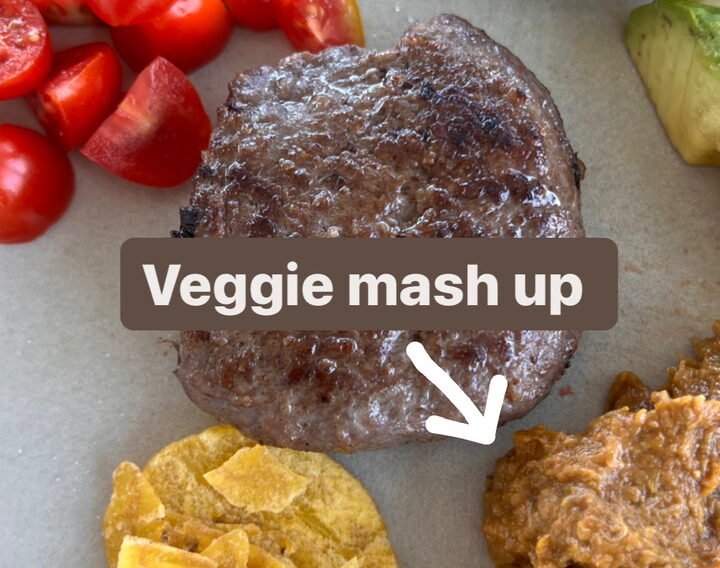Your biome is your body guard. It’s the backbone of your immune system and best protection against severe symptoms and pathogenic invasion. The good guys will crowd out the bad guys and all we have to do is feed them. Just like you would do a pet.
But feeding the biome is not easy work. There are three ways to support your biome. Prebiotics, probiotics and phytochemicals (also called polyphenols). Polyphenols and prebiotics are found in tea, herbs, cocoa and many fruits and veggies.
While probitiotics and fermented foods are very popular these days, they don’t replace lost strain or repopulate the biome. The only way to do that is to feed what is already there. Prebiotics are the best way to go if you want a thriving biome.
It’s recommended to eat 30 to 40 different veggies per week. That’s a bit daunting but here’s an easier way to give your body the diversity it craves.
Here is the good news. You don’t need much food to feed your bacterial army, just a little bit (they’re pretty small anyway).
You don’t need to spend money on fancy prebiotic powders, just eat food. That is why I am introducing you to the veggie mash up.
The veggie mash up was created by Dr. Datis Khazarian, and is medicine for your gut. My version is modified by cooking the veggies well to promote digestibility.
Because you’re consuming plant fiber in very small quantities, this makes it much easier to tolerate for those who are sensitive.
This works particularly for FODMAPS and histamine intolerance as the reactions depends on the quantity eaten. A tiny amount may be too small to trigger typical symptoms. If you are allergic or sensitive to a particular veggie, then simply leave it out.
How to make the veggie mash up
Go to the supermarket or better yet, the farmer’s market, and buy 1 each from different veggie types. Include root veggies (carrot, beet, parsnip, turnip, radish, sweet potato). Green veggies and cruciferous (kale, spinach, broccoli, cauliflower, cabbage, bok choy), fresh herbs, and anything else that’s fresh and available (asparagus, fennel, mushroom..etc.)
The idea is to consume a tiny amount each day to feed the biome without triggering symptoms. Start really small, the size of 1 ice cube or half an ice cube and increase slowly based on your tolerance.
Aim for between 12 and 20 fresh, local and organic veggies in your mash up. If you are ambitious and have access to lots of veggies you can add more.
Can you add in fruit?
Fruit digests at a different speed and could ferment in your belly when eaten with other food, so if you want to make a fruit mash up, then make that separately.
Cook the veggies well to make them easier to digest. Boil or roast them with your favorite oil until they are very soft.
Then blend the cooked veggie into a paste using a blender or food processor. Add a splash of veggie broth or bone broth to aid blending. Do this in small portions until done. Transfer veggie mash to a bowl and give it a good mix with a spoon.
Fill as many ice cube trays as you have with the veggie mash and freeze. Store frozen cubes in a freezer. You may have to freeze in phases until all your mash is frozen. They will last a few months in your freezer.
Every day, defrost 1 or 2 veggie cubes or add them frozen to smoothies or soups.
This hack takes the stress out of eating all your veggies (especially the ones you don’t like). A small daily amount is enough to support a diverse and happy biome, which will support you back.
While you can choose the veggies up you like for your mash up, it’s an opportunity to throw in ones you don’t like, don’t know what to do with or don’t usually eat.
Fortifying my biome has been my strategy for keeping IBS away for almost 20 years. Even when problems like parasite infections, pathogenic tick bites or leaky gut happened to me, my good bacteria helped me heal quickly without experiencing extreme symptoms.
If you want to know the status of your beneficial bacteria you could measure it with the GI Map stool test.
Over the years, I’ve noticed that the clients who do the best on their protocols or have the mildest symptoms are the ones with good levels of beneficial bacteria.
And if your biome need support, now you know how. Just like nature intended, through diet.
While it may be bit labor intensive at first, this biome hack will pay off by improving your gut health, immunity and intestinal integrity.
For biome-supporting treats and desserts, check out my Treats That Heal cookbook.


